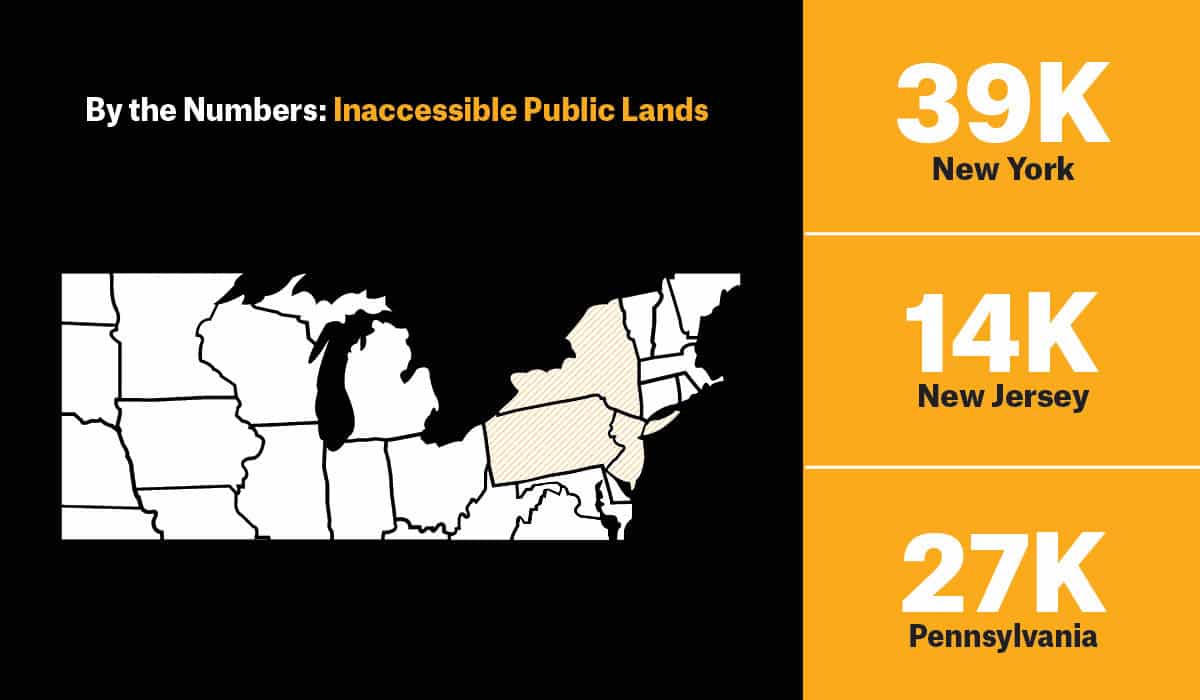Report: The Mid-Atlantic’s Landlocked Public Lands
In 2020, we are working with the Theodore Roosevelt Conservation Partnership (TRCP) to produce three regionally-specific landlocked reports. Our first report, released in early August, covered inaccessible public lands in the upper Midwest, highlighting more than 300,000 acres of public land in Minnesota and Wisconsin with no permanent, legal access.
In the second installment of our regional report series, we’re looking at untapped hunting and fishing opportunities in New York, Pennsylvania, and New Jersey. The Mid-Atlantic’s Landlocked Public Lands Report details more than 80,000 acres of public land with no permanent, legal access.
The report notes:
“These local, state, and federal public lands are legally open to public hunting and fishing, but they are surrounded by private land with no public roads or trails to reach them. Landlocked parcels range in size from just a single acre to many hundreds of acres and guarantee access to no one except the neighboring landowners and those with permission to cross private lands.
Today, when time in the outdoors is more valuable than ever, unlocking public lands represents one of the most obvious and actionable ways to provide more opportunities for more people to enjoy the woods and waters of our country.”

So, how can this acreage be opened up to the public? The report notes, “Landlocked public lands are best made accessible through cooperative agreements with private landowners that result in land exchanges, acquisitions, and easements, but this critical work cannot be undertaken without funding. When it comes to opening inaccessible public lands, even small projects can offer big benefits.”
Here are three regional programs that support such cooperative agreements:
New Jersey: Connecting Habitat Across New Jersey (CHANJ)
Recognizing the threat posed to wildlife by the increasing density of development within the state, New Jersey’s Department of Environmental Protection in 2019 launched an innovative program known as CHANJ to secure and improve habitat connectivity. By mapping core intact habitats and opportunities to establish corridors between them, the program helps guide strategic land acquisitions to benefit both game and nongame species, as well as sportsmen and women who enjoy new and improved access to public lands.

New York State: Environmental Protection Fund and the Open Space Conservation Plan
The New York State Environmental Protection Fund and the Open Space Conservation Plan work hand in hand to conserve natural resources and open space and provide for public access to outdoor recreation. Supported through a real-estate tax, the EPF provided $300 million toward a wide range of conservation programs in 2020 alone, and the land acquisition portion of the program has been funded at around $30 million annually in recent years.
Pennsylvania: Community Conservation Partnerships Program (C2P2)
Pennsylvania’s C2P2 program is administered by the Department of Conservation and Natural Resources to conserve and acquire land through several methods, including the acquisition of lands to be added to existing state parks, forests, and gamelands.
On a national level, the federal Land and Water Conservation Fund (LWCF) remains the most powerful tool available for establishing and expanding access to public lands and waters. And it just got more powerful, with the recent passage of the Great American Outdoors Act, fully funding the program at $900 million annually for wildlife conservation and outdoor recreation, including $27 million that is dedicated to public access. Importantly, the LWCF is not just limited to federal projects—at least 40 percent of the program must be used for state-driven projects. State Comprehensive Outdoor Recreation Plans, commonly referred to as SCORPs, are developed by each state to set priorities for state-side LWCF funded projects and represent a key opportunity to unlock public lands.
Ready to learn more? Read the full The Mid-Atlantic’s Landlocked Public Lands Report, along with our previous landlocked public lands reports, here. In 2018, we worked with TRCP to create “Off Limits, But Within Reach: the Federal Landlocked Report”, and in 2019, we joined forces for the “Inaccessible State Lands in the West” Report. With the foundation provided by those two larger-scale reports, we are now delving into regional access issues.
Our next report with TRCP, to be released this autumn, will cover landlocked public lands in the Southeast.